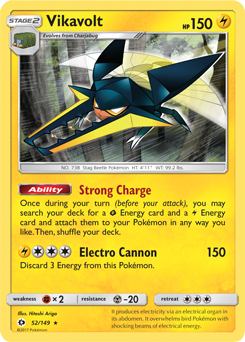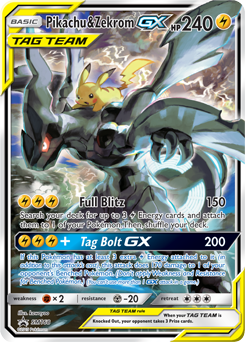The Electric Mouse Clubhouse – A Case for PikaJudge

Greetings PokeBeach readers! My name is Charlie Lockyer, and I’m ecstatic to be writing my first article for this incredible site. Writing for a major site has been a dream of mine for a while now, so finally getting a chance to do it is really exciting. For those of you who don’t know me, I’m a high school senior from Maryland who has been playing Pokemon since 2010 (competitively since 2015). I’m most known for playing somewhat off-the-wall decks to major events, including Tool Drop Doublade (NAIC 2019), Lost March (Roanoke 2018), Sceptile-GX / Vileplume / Cradily / Dragonite (Hartford 2019), and Tapu Bulu-GX / Vikavolt (Madison 2017). However, today I’m here to talk about the deck I played to 18th place at the 2019 World Championships: Pikachu and Zekrom-GX / Judge, also known as Supreme Court.
Having played oddball decks at so many events in the past, almost nothing was off the table when it came time for me to start testing the blind World Championships format. My biggest fear was inconsistency. With the loss of cards like Ultra Ball and Nest Ball, a majority of decks in the format were left with no reliable search option. Basically, if your deck wasn’t heavily GX-focused (Cherish Ball or Electromagnetic Radar for Lightning-types), Psychic- or Dragon-based (Mysterious Treasure), or had unique search options (Pokémon Research Lab and Professor Elm's Lecture come to mind), setting up was unreliable. Pokémon Communication was never reliable, especially in decks that ran a below-average amount of Pokemon. This quickly drove me away from decks without access to these reliable search cards because at a tournament like Worlds, more than one loss likely takes you out of the running for Top 8. I felt like I couldn’t afford to take losses to consistency issues, so I chose to mitigate them by building around consistency.
Choosing a Deck and Deck List
This observation quickly turned my testing towards decks such as Pikarom, Green's Exploration / Reshiram and Charizard-GX and Blacephalon-GX variants. In the weeks leading up to the event, Green’s ReshiZard and Blacephalon decks slowly fell off the list of decks I was willing to play (mostly due to reliance on Green’s Exploration and Tapu Fini respectively), leaving only PikaRom. My list looked a lot like Kaiwen Cabbabe’s Top 8 list sans Sigilyph-GX, including Jirachi and Cyrus Prism Star as a strong answer to setup decks such as Malamar. However, the Cyrus strategy failed at consistently beating Malamar decks due to the inability to find Cyrus exactly when you need it. Green’s ReshiZard was also extremely unfavorable in our testing due to its ability to build up a large hand of cards like Custom Catcher and Welder. We began digging for answers to these matchups, including Choice Helmet, Great Potion, and even Champions Festival, but none of them ended up changing the matchup enough to consider it favorable. Then, I remembered when my friend Justin Bokhari told our testing group to try putting two copies of Judge into our PikaRom list for the extra disruption against pretty much everything. After a few games, I responded by saying that while the two copies were underwhelming, upping it to four might be worth a try. Thus, PikaJudge was born.
This new, Judge-focused list was able to handle pretty much every deck we threw at it with the exception of Keldeo-GX variants. The strong disruption at any point in the game, including turn one, that Judge provided allowed the deck to consistently disrupt large hands, making combos like Welder, Custom Catcher, and Mixed Herbs harder to pull off. I emphasize “consistently disrupt” because the power of a turn one Judge is not the only reason we play four copies. As we anticipated opponents being able to draw out of our Judges more often than not, playing Judge a second, third, and fourth time, along with the power of our one Reset Stamp, made it nearly impossible for opponents to build up large hands. This consistent disruption meshes very well with the aggressive strategy that PikaRom decks are known for, allowing us to attack as early as turn one or two while our opponents struggle to set up. The Jirachi and Dedenne-GX-focused engine also provided the deck with unparalleled consistency, as we were able to see over 12 cards in a turn on most occasions. This gave us the chance to abuse the inconsistency this format was known for: why not build a list to do nothing but operate like a well-oiled machine in every game and also crush the many inconsistent decks in this format that needed more than 4 cards to set up? One of my friends (I forget who) boiled it down to this: why isn’t a deck that can still play Ultra Ball, Shaymin-EX, and Marshadow not the best deck by a country mile? All of these observations made PikaJudge our top choice for the tournament.
I played PikaJudge on both Day 1 and Day 2, along with my friends and testing partners Will Jenkins, Justin Bokhari, Jonathan Croxton, Justin Kulas, Emery Taylor, Ian Robb, and Isaiah Cheville. Will and I advanced through Day 1 into the second day, while Justin B., Justin K., and Ian had Day 2 invites. While I came very close to making Top 8, I ended up finishing 18th on Day 2. Justin B. finished 21st, Ian got 33rd, Will got Top 64, and Justin K. had a day full of poor draws. While we know how close we were to getting a chance at taking home the gold, we were happy with our performances.
I played the same list on Day 1, but I played Choice Helmet over Mew. This list is built to consistently disrupt opponents and attack with Full Blitz as early as possible. The only change I would consider would be a fourth Switch over an Escape Board.
Worlds Report: Day 1
R1 David Cooper, Jirachi PikaRom, WLL

Game 1 I got a solid start and he didn’t, Game 2 the opposite happened, and Game 3 he hit T1 Full Blitz off of Judge. I expected to be unfavorable against the mirror so this loss felt fine.
R2 Drew Kennett, MewMew Box, WW
Game 1 I played Judge on T1 and he bricked, Game 2 I was able to prevent him from winning by putting Choice Helmet on my ChuChu. I won the next turn. His MewMew list was much less consistent than some of the others I faced, making it much more prone to Judge.
R3 Masayuki Osajima, MewMew Box, LWW
Game 1 he played and drew extremely well, leading me to a quick loss. Game 2 I was able to deck him out as he milled too many resources with Hapu in the early game. Game 3 he drew-passed, which is once again expected of most MewMew lists at least once per set (Henry Brand’s winning list is the exception to this).
R4 Eric Brooks, Turbo PikaRom, WLL
Game 1 I drew well and outpaced him while he struggled to escape my onslaught of Judges. Games 2 and 3 I started with Koko Prism Star, 5 Lightning Energy, and a dead Item. Upset, but it happens and I can just win four more.
R5 Aaron Rozbicki, Blacephalon / Naganadel, WW
PikaRom is very favored against Blowns, especially when early-, mid-, and late-game Judges can cripple their setup. I limited him to one Beast Ring per game through Judge and took intelligent KOs with Chuchu and Zeraora, giving me an easy victory.
R6 Gregory Fortier, Turbo PikaRom, WW
I was pretty worried when Gregory flipped over PikaRom, but I was able to draw consistently well and pull off a 5-prize Full Blitz both games after taking an early kill on Dedenne. A combination of strong draws on my side and a few missing pieces to every combo on Gregory’s side allowed me to cruise to another quick victory.
R7 Thiago Giovanetti Marques Ricardo, Malamar, WW
I played against Thiago at 2017 Worlds and remembered him fondly as a great opponent. This continued into our next match, but this time he was playing a heavily teched-out Malamar variant with Gengar and Mimikyu-GX and Shrine of Punishment. Game 1, I was able to take a late KO on his MimiGar with a double Electropower-boosted Tag Bolt GX after we traded Prizes evenly for most of the game (I struggled to find Lysandre Labs and Hoopa at the same time). Game 2, he had an opportunity to potentially win the game by using Horror House GX before attacking into my PikaRom, but I bluffed having all five Trainer cards needed for the Knockout by slightly adjusting my general temperament as he benched MimiGar. When he used Poltergeist, I revealed four Trainer cards, drew for turn, Benched Hoopa, attached, and attacked MimiGar for game due to the 20 damage already placed on it from Shrine of Punishment. This was a much closer set than the 2-0 reveals, props to Thiago for playing it so well.
R8 Fabio Gomes, Baby Blacephalon, LWW
Not gonna lie, I was pretty excited when my opponent flipped over two baby Blacephalon knowing how many disruption options I had at my disposal. However, my nerves quickly set in as he proceeded to run me over in Game 1. I stayed calm throughout Game 2 though as I Judged him into a situation where he would have to wait multiple turns before attacking again; he promptly conceded. In Game 3, things got tense: I was 10 damage short of donking his baby Blacephalon with double Electropower-boosted Tingly Return GX, but still did it anyways and finished off the baby Blown with a 10-damage Evil Admonition next turn. We traded Prizes for a bit as he consistently drew out of my Judges, and it came down to the point where he realized his last Fire Energy was prized – leaving him 40 damage short of a Day 2 berth. I was able to pull off a Tag Bolt GX for the game next turn, punching my ticket to Day 2 at the World Championships once again!

After dinner, I went to Isaiah Bradner’s hotel room again to theorize the metagame and make final decisions for Day 2. Much of our theories focused on the mysterious Team DDG / Gang Secret Deck and how to beat it (keep in mind, we had absolutely no clue what it was). From hearing rumors that it “beat everything” and “nobody has posted anything like it”, we concluded that our only way to tech against the deck was to stick with PikaJudge for its disruption power and ability to beat anything through giving it a bad hand. Unbeknownst to us, DDG / Gang was playing an Oranguru / Pidgeotto Control deck, which turned out to be a highly favorable matchup for us. We felt confident going into the tournament and simply hoped for the best as we dreamed of what could come in less than 24 hours.
This concludes the public portion of this article.
If you'd like to continue reading, consider purchasing a PokeBeach premium membership! If you're not completely satisfied with your membership, you can request a full refund within 30 days.
Each week we post high-quality content from some of the game's top players. Our article program isn't a corporate operation, advertising front, or for-profit business. We set our prices so that we can pay the game's top players to write the best content for our subscribers. Each article topic is carefully selected, goes through multiple drafts, and is touched up by our editors. We take great pride in our program!

